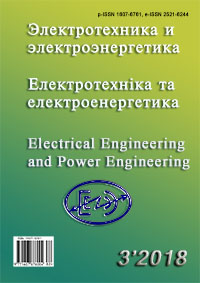DISTRIBUTION OF THE POWER OF THE A POWER ACTIVE FILTER BOOSTER TRANSFORMER FOR REGULATING OF THE NONLINEAR VOLTAGE DISTORTIONS COEFITIENT
DOI:
https://doi.org/10.15588/1607-6761-2018-3-2Keywords:
power quality, serial power active filter, series transformer, voltage distortionAbstract
Purpose. Investigate the parameters of the mode and distribution of the power of the transformer of the booster when adjusting the coefficient of the nonlinear distortion of the voltage.
Methodology. Methods of electrical engineering, numerical simulation methods, Fourier series methods.
Findings. The analysis of the transformer is carried out, the processes taking place in the transformer are considered, the filter model is developed in the visual programming environment, based on the analysis of which the application efficiency of the proposed solution is shown by the load voltage distortion. To assess the influence of the transformer on the operating mode of the device, a series of experiments was carried out. In the case of distortion of supply voltage, a serial active power filter is used that connects to the network through series transformers, which results in changes in the parameters of the equivalent power load circuit. As a result of the research it was established that the transformer of a series power active filter in the series mode, in case of compensation of voltage distortion of the network in general, has the voltage and current of the windings, the harmonic composition of which is different, this leads to a broad harmonious composition of the power of the transformer, which needs to account for the growth of losses in windings. and the magnetic circuit. The conclusions are drawn that to the effect of the parameters of the transformer on the operation of the active filter.
Originality. For the first time a model of an equivalent force single-phase sequential filter has been developed, which, unlike the existing one, takes into account the effect of the series transformer on the parameters of the mode.
Practical value. The internal resistance of the transformer and the load current lead to the emergence of voltage harmonics, which additionally affects its quality, and in the case of an experiment made up 2,35%. An increase in power losses in a transformer of a power active filter requires an adjustment of the method of its selection, taking into account distortion of voltage and current.
References
[1] Sankaran, C. (2017). Power quality.Florida: CRC press, 216.
[2] Bhim, S., Ambrish, C., Kamal, A. (2014). Power quality.NewYorkCity: John Wiley & Sons, 600.
[3] Dugan С., Mcgranaghan F., Santoso S. (2012). Electrical Power System Quality.New York City: McGraw-Hill Education, 580.
[4] Thomas F. Schubert Jr., Ernest M. Kim (2016). Fundamentals of Electronics: Book 3 Active Filters and Amplifier Frequency Response.San Diego: Morgan & Claypool Publishers, 292.
[5] Lin Tayzar (2016). Design of Shunt Active Filter & Harmonic Compensation. LAP Lambert Academic Publishing, 253.
[6] Mohammad, A.S. Masoum, Ewald F. Fuchs (2015). Power Quality in Power Systems and Electrical Machines.Cambridge: Academic Press, 1141.
[7] Akagi, H. Watanabe, E. H. (2017). Instantaneous power theory and applications to power conditioning.Piscataway: IEEE Press, 454.
[8] Kolb, A.A. (2009). Elektromagnіtnі procesi v silovih aktivnih kompen-satorah neaktivnih skladovih potuzhnostі [Electromagnetic processes in power active filters of inactive components of capacity]. Transaction of Kremenchuk State Polytechnic University, 2, 160-165. [inUkraine].
[9] Zhujkov, V.Y. (2011). Osoblyvosti rezhymiv roboty FKP [Specialized mode of work FKP]. Tekhnichna elektrodynamika,. 1, 24-29 [inUkraine].
[10] Alekseev, B.A. (2007). Aktivnyye fil'try vysshikh garmonik [Active filters of higher harmonics]. Elektro, 3, 28–32 [inRussia].
[11] Bondarenko, S., Bialobrzheskyi, О., & Vlasenko, R. (2018). Investigation of the influence of the transformer of a series active filter on the quality of voltage. Electrical Engineering And Power Engineering, 1, 93-101. doi:http://dx.doi.org/10.15588/1607-6761-2018-1-10 [inUkraine].
[12] Ivanov, I.I., Solovev, G.I., Frolov, V.Ya. (2016). Elektrotekhnika i osnovy elektroniki [Electrical engineering and basic electronics]. Lan, 736 [inRussia].
[13] Kuvshinov, G.E. (2016). Skhemy zameshcheniya transformatora [Schemes of substitution of the transformer]. Far EasternFederalUniversity, 136.
[14] Vlasenko, R.V., Byalobrzheskij, O.V. (2018). Limitations of current of the three-phase active power filter in the conditions of overload and short circuit. Electrical Engineering & Electromechanics, 2, 29-34 [inUkraine].
[15] Chernyh,I. (2011). Modelirovaniye elektrotekhnicheskikh ustroystv v Matlab, SimPowerSystems i Simulink [Modeling of electrical devices in Matlab, SimPowerSystems and Simulink]. DMK Press, 288 [inRussia].
[16] Zakis, J., Vinnikov, D., Laugis, J., Rankirs,I. (2010). Feasibility study of flexible systems for reactive power compensation. Springer, 14-20.
[17] WangMan-Chung, Lei WongChi-Seng, Lam (2018). Adaptive Hybrid Active Power Filters.New York City: Springer, 232 p.
[18] Vangenthaym, F. L. (2010). Active Filter und Oszillatoren. Technosphere, 416.
[19] Vlasenko, R., & Bialobrzeski, O. (2016). Correction algorithm for determining the given current active power filter based on the theory power fryze in terms of asymmetry. Electrical Engineering And Power Engineering, 1, 57-63. doi:http://dx.doi.org/10.15588/1607-6761-2016-1-8 [inUkraine].
Downloads
Published
How to Cite
Issue
Section
License
Copyright (c) 2018 S.S. Bondarenko, О.V. Bialobrzheskyi

This work is licensed under a Creative Commons Attribution 4.0 International License.
Creative Commons Licensing Notifications in the Copyright Notices
Authors who publish with this journal agree to the following terms:
Authors retain copyright and grant the journal right of first publication with the work simultaneously licensed under aCreative Commons Attribution License that allows others to share the work with an acknowledgement of the work's authorship and initial publication in this journal.
Authors are able to enter into separate, additional contractual arrangements for the non-exclusive distribution of the journal's published version of the work (e.g., post it to an institutional repository or publish it in a book), with an acknowledgement of its initial publication in this journal.
Authors are permitted and encouraged to post their work online (e.g., in institutional repositories or on their website) prior to and during the submission process, as it can lead to productive exchanges, as well as earlier and greater citation of published work.

